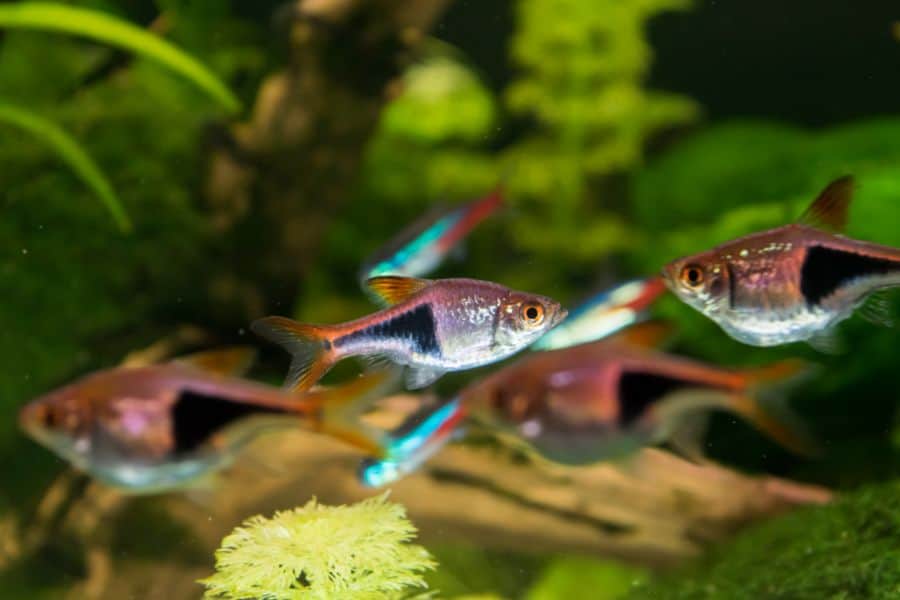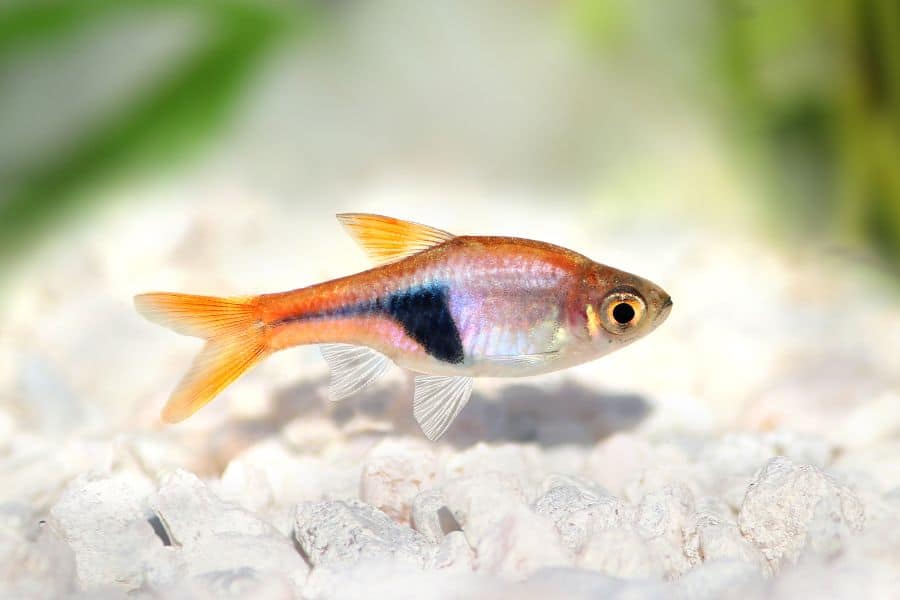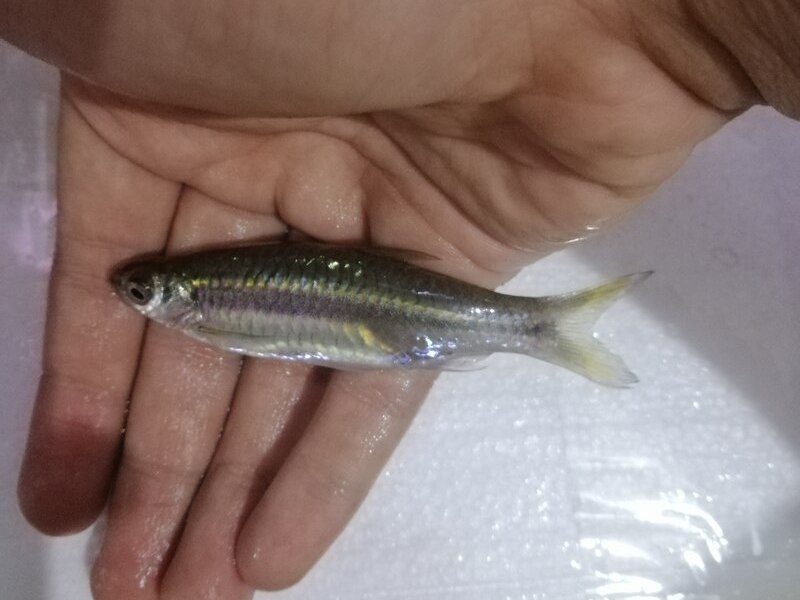Rasboras are tropical Cyprinidae species native to different parts of Southeast Asia. They rank among the most stunning, vibrant, and calm tiny fish for aquariums at home.
Rasbora has a lot of varieties, so it’s wise to learn about the different kinds before owning one. The majority of rasboras are omnivorous, while some choose to consume more live food than plants.
These species flourish in clusters since they are certainly schooling animals. It alleviates anxiety and distress while also providing a level of stability.
In this post, we’ll discuss the various rasbora species and each one’s distinctive traits to help you pick the perfect one for your tank setting.
Rasbora Overview
- Family: Cyprinidae
- Size: 2-4 inches
- Life expectancy: 5–8 years
- Diet: Omnivore
- Temperament: Peaceful
- Minimum tank size: 10 gallons
- Temperature: 72–81°F
- Water pH: 4.5–7.8 pH
- Water hardness: 2–15 d GH
- Care level: Easy
11 Best Types of Rasbora Fish for Beginner Aquarists
1. Harlequin Rasbora
- Scientific name: Trigonostigma heteromorpha
- Size:75 to 2 inches
- Care level: Easy
- Required Tank Size: 10-20 gallons
Some of the oldest well-known varieties of rasboras are the harlequin. In addition, they are among the greatest widely maintained fish in aquariums overall.
Harlequin species are found in Southeastern Asian seas. The distinctive feature of Harlequin Rasboras is their shining golden bellies, which are often decorated with a deep black triangular shape.
These little fish require very little maintenance and only expand approximately 1.5 inches long. Harlequin Rasboras must be kept in aquariums with the least capacity of 10 gallons, but considering they are swarming species, you must go for a bigger size.
In order to keep the Harlequin Rasbora healthy, the water pH of the aquarium must be kept between 5.5 and 7.5. The ideal temperature for a Harlequin Rasbora aquarium is around 70 and 80°F.
A heater is necessary to reach and keep up with certain conditions. Harlequin Rasboras could be fed tiny amounts of both fresh and refrigerated meat because they are predatory animals.
However, the majority of Rasbora varieties that are maintained in confinement are offered shavings or tiny pellets. Harlequin Rasboras are very desired and well-liked due to their flexibility in maintenance, particularly in regard to their food and aquarium settings.
2. Chili Rasbora
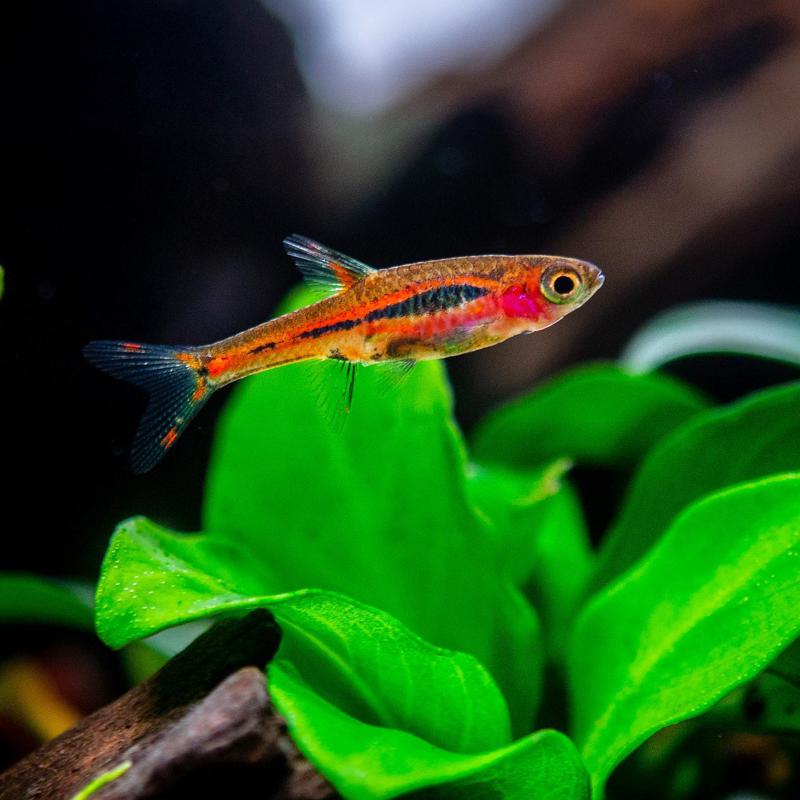
- Scientific name: Boraras brigittae
- Size:7 inches
- Care level: Easy to moderate
- Required Tank Size: 5 to 10 gallons
Chili Rasbora is a tiny, calm schooling species native to Indonesia’s Southwestern Sumatra region. It may give your tank a special touch.
The majority of tiny species prefer to be in swarms for safety, and Chili Rasboras are no exception. Although these species exhibit their stunning red and black colors, they continuously travel in the aquarium together.
Appropriate adjustment is essential for Chili Rasbora’s safety and happiness whenever it is originally exposed to unfamiliar surroundings.
You have to build up a well-equipped aquarium with lots of décor, hidden passageways, and real plants because they could be nervous during their early weeks in confinement.
In terms of aesthetics, Chili Rasboras feature an intriguing, vibrant appeal that includes enticing rose and red tones as well as two lines that run straight down their spines and are entirely comprised of captivating red and deep black.
3. Brilliant Rasbora
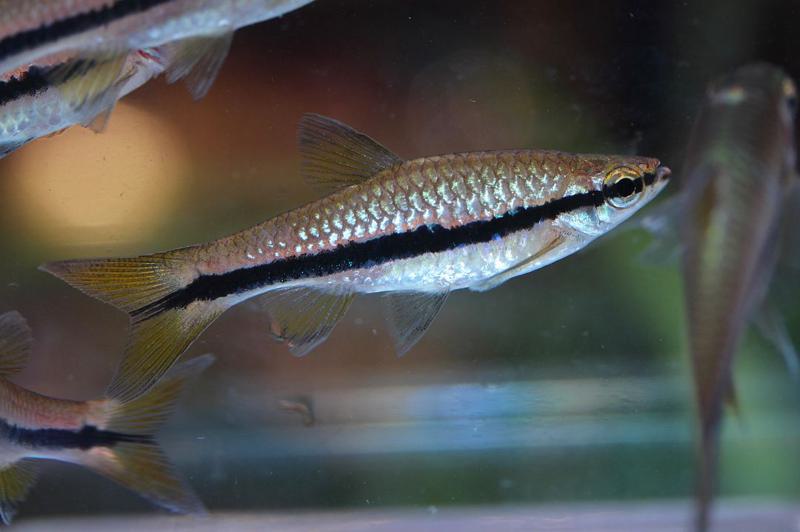
- Scientific name: Rasbora einthovenii
- Size: 3-3.6 inches
- Care level: Easy
- Required tank size: 30 gallons
The Brilliant Rasbora is endemic to the Indonesian islands of Sumatra and Borneo, where they are found in heavily vegetated rivers and streams. Their peaceful nature makes them an ideal addition to any aquarium.
Brilliant Rasboras boast a dazzling silver hue, with a much brighter iridescence on their scales than other rasbora species. They have the same black line along their sides, just like the Blackline Rasbora, but they’re a lot more vivid. They also have a pinkish or faint red line running through half of their body.
This Rasbora variety is on the larger side, as they can grow up to around 3.6 inches. Plus, to feel safe and content, these fish require a group of at least six members, which means you’ll need to provide them with at least a 30-gallon aquarium so that they have plenty of room to move around and explore.
In terms of diet, Brilliant Rasboras should be fed a variety of food sources, such as live fish foods, frozen food, and even flake food.
They’re omnivorous, so they don’t have any specific dietary requirements. They may even try to eat small invertebrates in the tank, so it’s a good idea to keep them away from any sensitive species.
4. Strawberry Rasbora

- Scientific name: Boraras naevus
- Size: 7 inches
- Care level: Easy
- Required tank size: 5 gallons
Strawberry Rasboras are among the tiniest rasbora species, as they only grow up to 0.7 inches long. This makes them ideal for smaller aquariums. These tiny fish are found in parts of India, Thailand, and Malaysia, where they inhabit shallow streams with thick vegetation.
This Rasbora variety got its name from its signature red coloration that resembles a strawberry. They also have a black dot on their sides and bright red-orange tips on their fins.
Strawberry rasboras are very peaceful and are best kept in small groups of at least six, but 10-15 is better. They require a tank of at least 5 gallons, preferably larger, with plenty of vegetation and hiding spots for them to feel safe.
They are omnivorous and will happily accept a variety of food sources like frozen, freeze-dried, live, and flake food. Keep in mind that they are small, so you need to make sure the food isn’t too large for them to eat.
5. Scissortail Rasbora
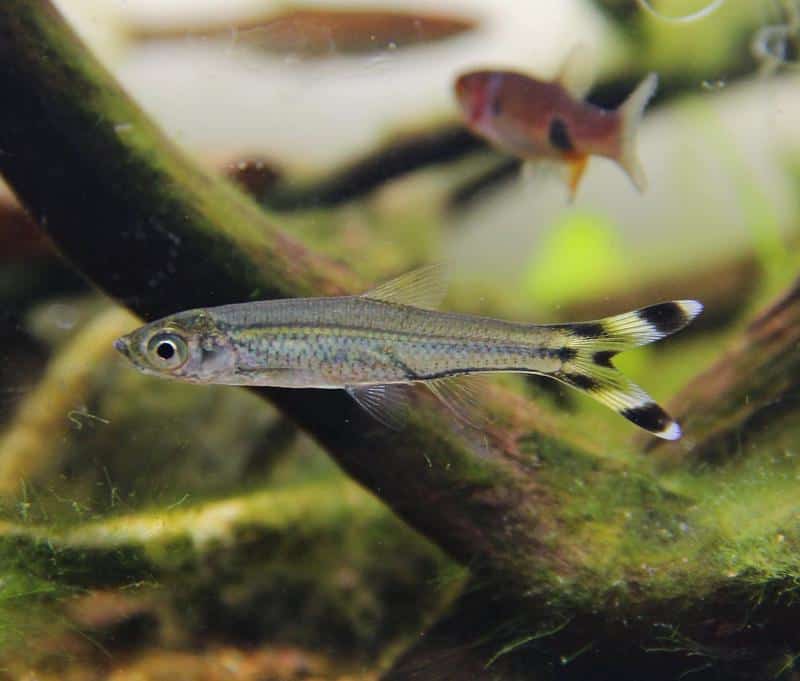
- Scientific name: Rasbora trilineata
- Size: 6 inches
- Care level: Easy
- Required Tank Size: 20 gallons
Scissortail Rasboras are larger than the majority of Rasbora species. They have an exceptional growth potential than the majority of Rasboras, reaching the highest possible length of 6 inches.
Scissortail Rasboras are native to Indonesia and Kalimantan regions, along with Laos, Myanmar, Vietnam, and the Malaysian coast. Three-Lined Rasbora is another name for Scissortail Rasboras.
They feature a black strip that extends the height of their almost clear abdomen. They possess a corkscrew in their rear as well as three different colored streaks.
The term “Three-Lined Rasbora” refers to the three vibrant streaks. The aquarium conditions for these giant rasboras are more demanding than those for the majority of rasbora varieties.
The recommended water pH of a Scissortail Rasbora aquarium is around 6.6 to 7.0, which gives no tolerance for a mistake. It implies that you must constantly monitor the pH concentration to guarantee that it isn’t changing to the extent that it can harm the animals in your aquarium.
Your aquarium has to maintain a temperature from 73 to 78 °F; install a thermostat to be certain it does.
6. Clown Rasbora
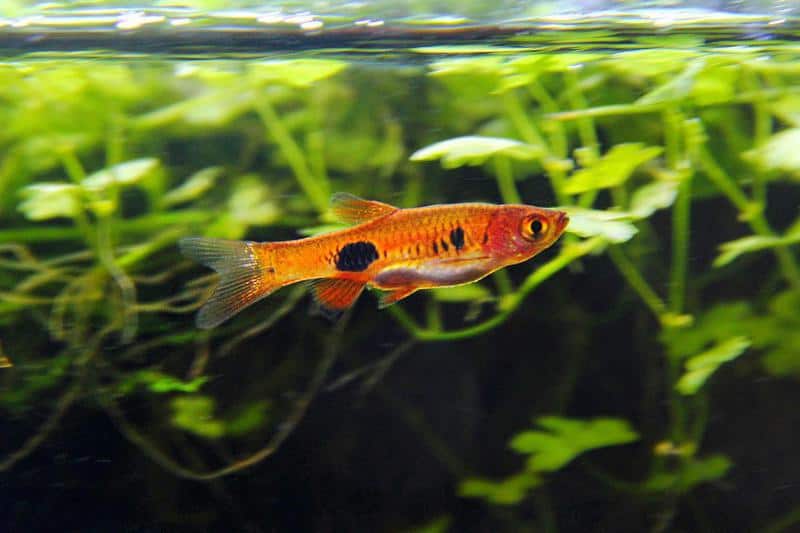
- Scientific name: Rasbora kalochroma
- Size: 4 inches
- Care level: Easy to moderate
- Required Tank Size: 40-60 gallons
The next gentle species that may thrive in a social environment is the clown rasbora. The fish’s special requirements make it difficult to find the best tank companions.
This particular kind of rasbora grows in wetlands and Blackwater Rivers. These waterways are muddy and alkaloid.
Because of the changing ocean chemical reactions caused by decomposing plant materials, certain fish cannot survive there. Clown Rasboras tolerate water with an acidic level of 4!
They seem to like poorly lit environments with debris, rotting leaves, and hanging vegetation. Pinkish-orange coloration develops in these species as a result of this.
In addition, their bodies contain patchy black markings. These markings are unique in length, structure, and placement.
As a result, every fish would be different. It is helpful since these fish prefer to gather in bigger numbers. They enjoy clusters of 8 to 10, similar to Harlequin Rasbora.
7. Lambchop Rasbora
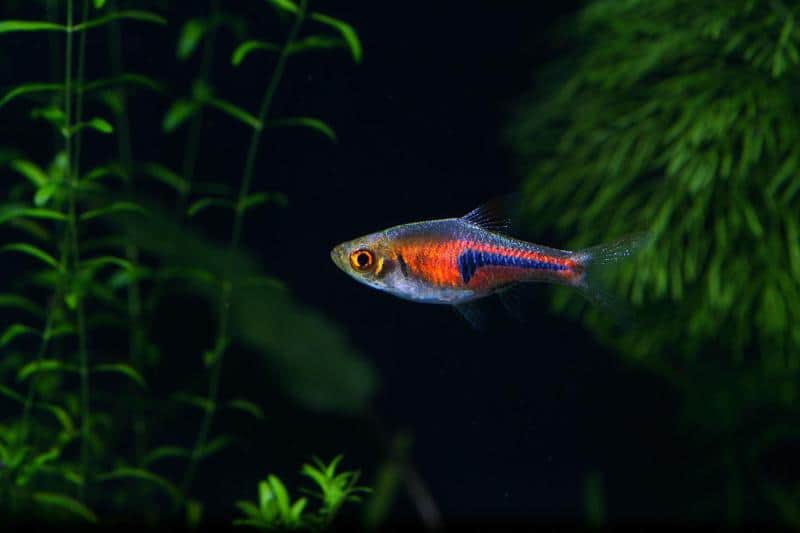
- Scientific name: Trigonostigma espei
- Size: 1-1.5 inches
- Care level: Easy
- Required Tank Size: 10 gallons
Lambchop Rasboras are indeed a wonderful addition to your aquarium since they require minimal maintenance. Their title is inspired by a unique black pattern on their colorful abdomen that looks like a lamb chop.
It is advised that you keep no more than 6 Lambchop Rasboras inside a 10-gallon aquarium. Any number above that is not advised since there will be little to no room for each fish.
Lambchop Rasboras can be spotted in Southern Asian freshwater waterways and channels. Since their natural habitats usually have tropical conditions, you must recreate them in an aquarium habitat.
The ideal temperature for an aquarium housing Lambchop Rasboras should be 73 to 83 degrees Fahrenheit. The pH level of such aquariums must range from 5.5 to 7.9.
Lambchop Rasboras are opportunistic feeders, which means they may be fed a mix of live food and vegetables. They may consume shavings or granules when kept in confinement, but this shouldn’t be their primary diet.
Lambchop Rasboras can live a long and healthy life in your home tank if you provide them with balanced nutrition and an optimal environment.
8. Dwarf Rasbora
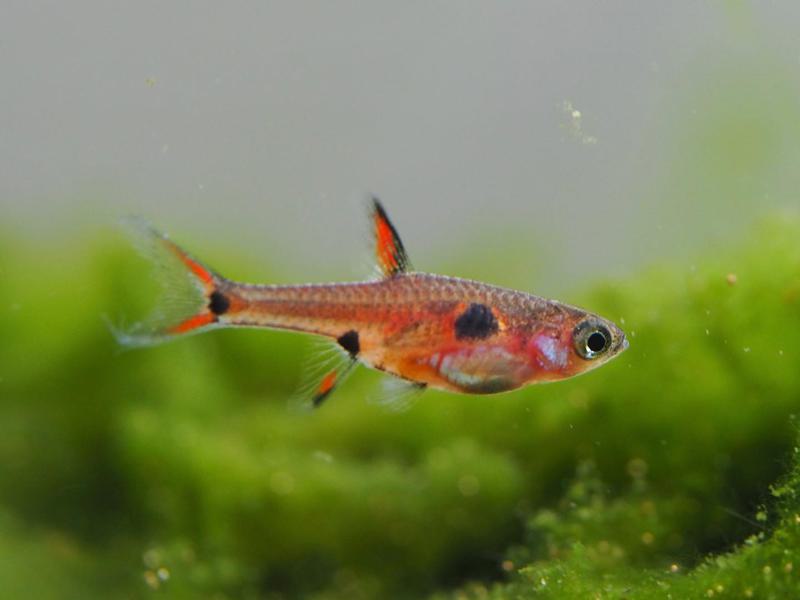
- Scientific name: Boraras maculatus
- Size:8 inches
- Care level: Easy
- Required Tank Size: 5 to 10 gallons
A big group of Dwarf Rasbora could be housed in a medium-sized aquarium. These species, often referred to as Pygmy Rasboras, like to gather in teams of six.
However, they tend to do better when there are above 20! These species would travel around each other and make a lot of energy in your aquarium when they are gathered in big numbers.
Their swimming is remarkable, and your tank will look amazing because of its unique charm! The fish start to turn a deep shade of crimson.
Deep black markings scattered across the body provide a striking contrast. The same is true with the orange speckles that encircle the markings!
If you want them to grow healthy, the dwarf rasbora needs ideal water parameters. It requires clear water and vegetation.
You can achieve the finest outcomes by replicating the alkalinity and tannin intake of their native home. They can even survive at pH values of 4.0. These species could also flourish in temperatures ranging from 68 to 82 degrees Fahrenheit.
9. Phoenix Rasbora
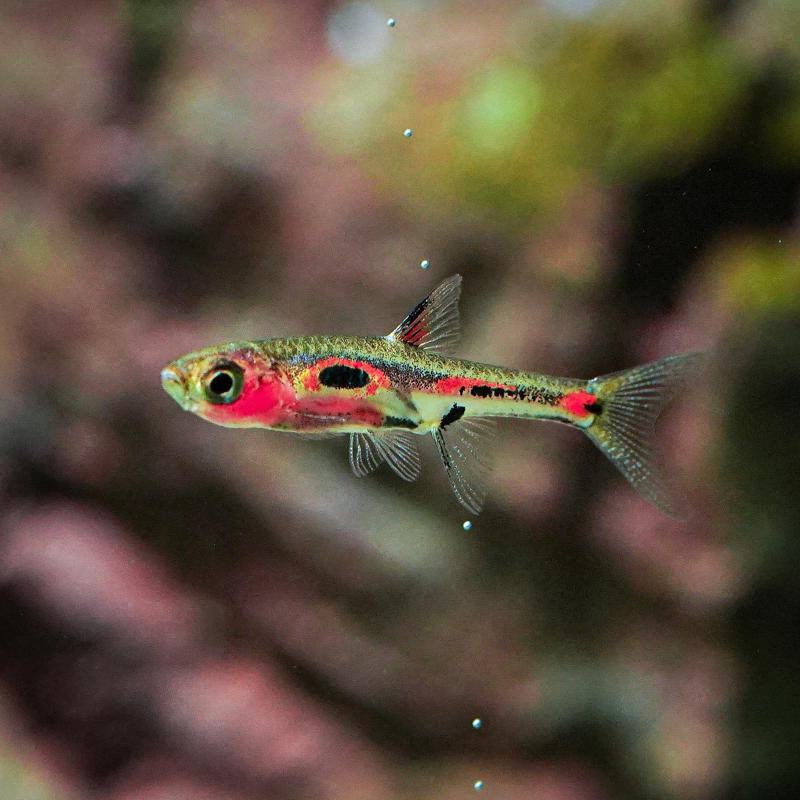
- Scientific name: Boraras merah
- Size:5-0.8 inches
- Care level: Easy
- Required Tank Size: 5 gallons
Southern Kalimantan is the original home of Phoenix Rasbora, sometimes referred to as Merah Rasbora. They are distinguished by their tiny size and vibrant red shade.
Phoenix Rasboras can reach a maximum length of about 0.8 inches. They are, therefore, the ideal size for a compact aquarium.
The term “Merah” means “red” in Indonesian culture. These species are a perfect shade of red and hence are given this title.
Phoenix Rasboras are carnivorous creatures known as tiny predators. They may devour everything that could squeeze in their jaws; however, they often consume caterpillars, microalgae, small invertebrates, or bugs.
The main challenge while attempting to offer food to your Phoenix Rasbora is presuming the bits are thin and chopped finely to fit into their small mouths. Phoenix Rasboras require an aquarium that is tailored to their special requirements.
Their surroundings must be around 68 to 82 degrees Fahrenheit. A Phoenix Rasbora aquarium’s pH level should be between 4.0 and 7.0.
In order to replicate their natural surroundings and contribute to making them feel happy and satisfied, you should also keep in mind to keep your aquarium full of plants.
10. Blackline Rasbora
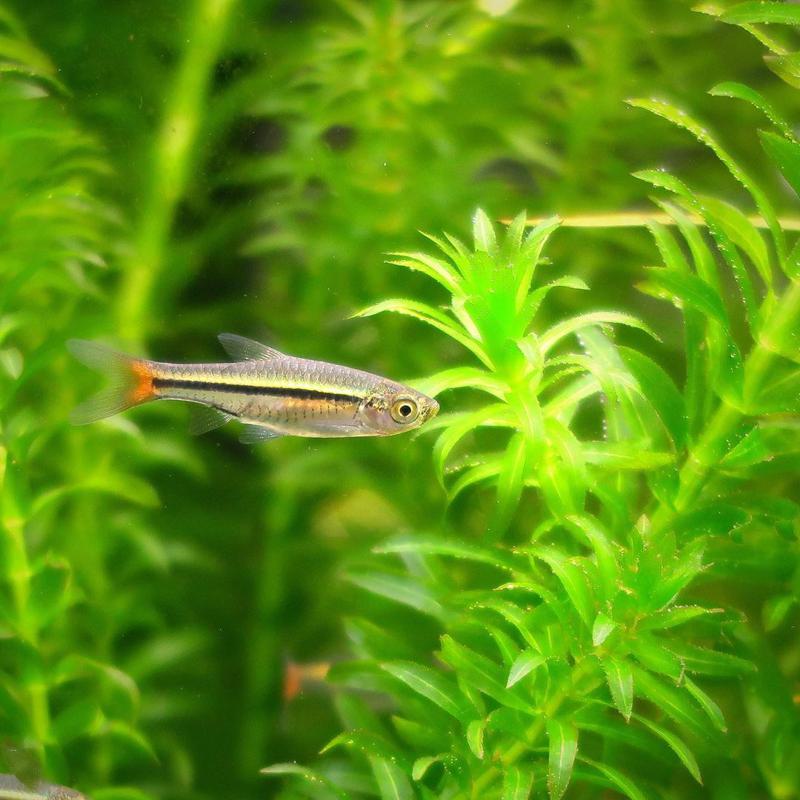
- Scientific name: Rasbora borapetensis
- Size:5 inches
- Care level: Easy
- Required Tank Size: 15-20 gallons
The Blackline Rasbora, also known as Red-Tailed Rasbora, is a highly resilient species that is typically present in various places across Southeastern Asia.
Like the Brilliant Rasbora, it also has black lines along its body, as well as orange, yellow, or red lines. One way to tell the two apart is by looking at their tail – the Blackline Rasbora has a red or orange spot right at the base of its caudal fin , hence its nickname.
The Blackline Rasbora usually lives in contaminated waterways. However, it prefers still lakes and channels. Its resilience makes tank living a good fit. Water adjustments do not have a significant impact on them.
The Blackline Rasbora will remain unaffected as far as you keep them within the acceptable limit. The species loves warmer conditions, around 72 to 79 degrees.
A balanced pH equilibrium and mild freshwater are also necessary. The Blackline Rasbora is named after its significant qualities.
The body is mainly clear and grey. But, a narrow black line stretches horizontally from the fin cover to the rear.
In addition to its black band, there is a yellow line just above it. Moreover, there is a crimson patch at the end of its body.
11. Yellowtail Rasbora
- Size: 6 inches
- Care level: Easy to moderate
- Required Tank Size: 30-60 gallons
Another variety of rasbora fish that enjoys living in alkaline conditions is Yellowtail Rasbora. These species are found in blackwater channels that are linked to pine wetlands in the animal world.
They could survive in areas where the pH ranges from 6 to 7.5. However, they do not require high alkalinity to thrive.
Since they are so adaptable to their surroundings, they are excellent options for shared aquariums.
Their abdomen is coated in dazzling silver and yellow. That’s how they got their title; it features a beautiful luminous appearance that shines in the sunlight.
They have two stripes, brown and yellow, that run along their entire body. They have a beautiful yellow and black color on their tail as well.
The Yellowtail Rasbora’s nutritional habits are one surprising trait. In their native environment, they are classified as tiny predators. Bugs, larvae, and invertebrates are among their favorite foods.
They are willing to eat dry food items in tanks. However, it should not be their entire source of nutrition.
Give your pet a lot of protein-rich living or frozen meals. It would maintain their well-being and help their color to pop up more.
Read More:
Types of Rasbora: FAQs
Why Is the Celestial Pearl Danio Called a Galaxy Rasbora?
The celestial pearl danio (Celestichthys margaritatus or Danio margaritatus) is often referred to as galaxy rasbora because when it was first discovered, hobbyists mistook it for a rasbora variety.
It was almost a year later, in 2007, when scientists discovered that it’s not a rasbora at all.
By the time they made the announcement, the name “galaxy rasbora” was already well-known in the aquarium trade, which is why we can still see aquarists refer to them as galaxy rasboras to this day.
Is the Blackline Rasbora and The Brilliant Rasbora the Same Fish?
The blackline rasbora (Rasbora borapetensis) is a different species from the brilliant rasbora (Rasbora einthovenii), even though both are referred to by hobbyists as “brilliant rasbora” for their iridescent scales.
Scientifically, r.einthovenii has the official common name of brilliant rasbora, though. Both fish have a black line going horizontally along their bodies, but the blackline rasbora has another interesting trait: a red spot right on its tail, earning it the nickname red-tailed rasbora.
What’s the Difference Between a Danio and A Rasbora?
Rasboras and danios may seem like the same fish at first glance. After all, they’re both minnow species belong to the same family, Cyprinidae. There are a few small differences, though.
One, danios tend to be more active than rasboras, although both species are pretty lively.
Two, rasboras prefer slightly warmer water than danios.
Three, while the exact physical characteristics vary from one rasbora and danio species to another, rasbora species tend to have a somewhat rounder and stockier profile, while many danio species tend to be on the slimmer and more streamlined side.
What Type of Rasbora Variant Is the Smallest?
There are a number of small rasboras. The Glowlight and Dwarf varieties grow to a maximum size of 3 cm. Another is Boraras Micro, which only grows around 1 or 2 cm.
Do Different Rasbora Varieties Join the Same Schooling Group?
Many rasbora varieties can join the same schooling group. However, some rasbora variants only allow their own species to join their group.
It’s impossible to predict which variants would assemble in a group together. It looks like it takes place on an individual basis.
How Many Rasboras Can We House Together?
Rasboras are swarming species, so in order to thrive, they need at least six companions. More than that is optimal, but 6 is enough. So, the tiny variants require more buddies to stay happy.
Conclusion
Rasboras are among the prettiest, most colorful, and most energetic species to keep in your household tank. They are usually quite calm and cheerful while swimming with their own variety.
They develop spectacular shades if they are healthy and nourished. However, there are several varieties of rasboras, and not every species are suitable for inexperienced enthusiasts.
However, the majority of these species are ideal for beginners and are quite simple to maintain. Every fishkeeper has their own inclination. Thus you could be more drawn to a particular species’ appearance over others.
In the end, it is up to you to choose a perfect rasbora that could fit well with your lifestyle and home environment. After all, there’s nothing more peaceful than watching your fish enjoying their new home!
